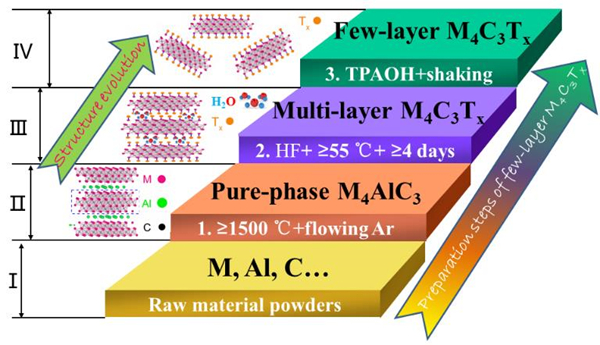
Researchers from Hefei Institutes of Physical Science (HFIPS) of Chinese Academy of Sciences (CAS) proposed an optimized synthesis strategy recently to obtain defect-free low-layer M4C3Tx (M = V, Nb, Ta) MXene nanosheets successfully.
These findings have been published in Advanced Science.
MXene materials have enormous potential for applications such as energy storage, energy conversion, and electromagnetic shielding because of their excellent physical and chemical characteristics. M4C3Tx (M = V, Nb, Ta) MXenes have received a lot of attentions. However, acquiring a pure MAX phase precursor, completely etching for multi-layer M4C3Tx MXenes, and stringent requirements for intercalation agents and exfoliation operations are all difficulties in the synthesis of these few-layer M4C3Tx MXenes. As a result, only few investigations have, up till now, concentrated on the examination of few-layer M4C3Tx (M = V, Nb, Ta) MXenes.
In this research, scientists proposed a roadmap for synthesizing defect-free few-layer M4C3Tx (M = V, Nb, Ta) nanosheets. It involved high-temperature calcination, HF selective etching, intercalation, and exfoliation. It produced three distinct defect-free few-layer M4C3Tx (M = V, Nb, Ta) nanosheets. Comprehensive characterizations have confirmed their defect-free structure, significant interlayer spacing (ranging from 1.702 to 1.955 nm), diverse functional groups (-OH, -F, -O), and abundant valence states (M5+, M4+, M3+, M2+, M0).
Moreover, they fabricated a free-standing film by vacuum filtering a few-layer M4C3Tx (M = V, Nb, Ta) MXene ink, which exhibited remarkable physicochemical properties such as high conductivity, high stability, and hydrophilicity.
"Our work provided detailed guidelines for the synthesis of other defect-free few-layer MXene nanosheets," said HUANG Yanan, member of the team, "also it served as a catalyst for extensive exploration of functional applications of M4C3Tx (M = V, Nb, Ta) MXene nanosheets in the future."

Figure 1. The preparation steps and the corresponding structure evolution of few-layer M4C3Tx (M = V, Nb, Ta) MXenes. (Image by HUANG Yanan)

Figure 2. The TEM results of defect-free few-layer V4C3Tx MXene nanosheets. (Image by HUANG Yanan)